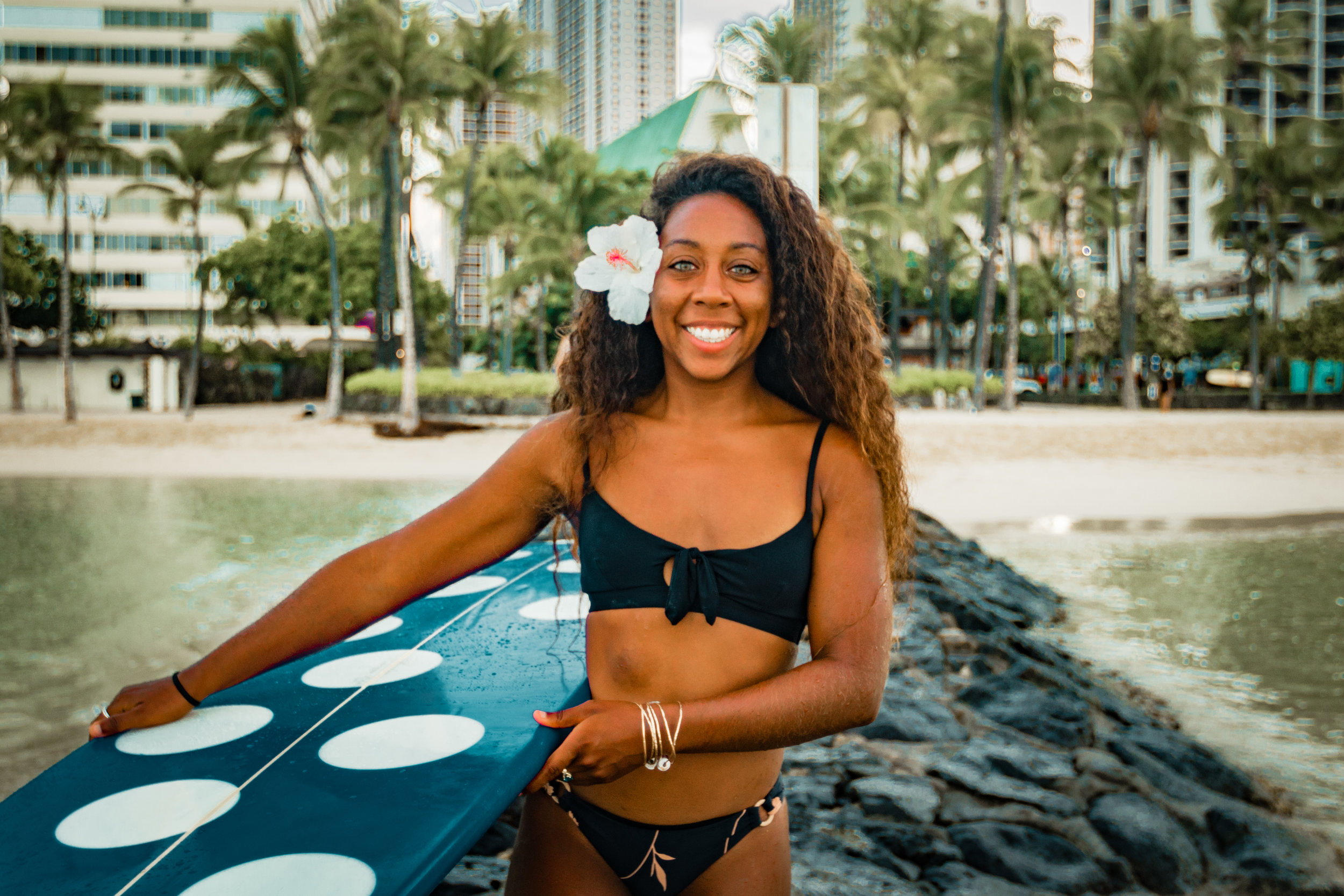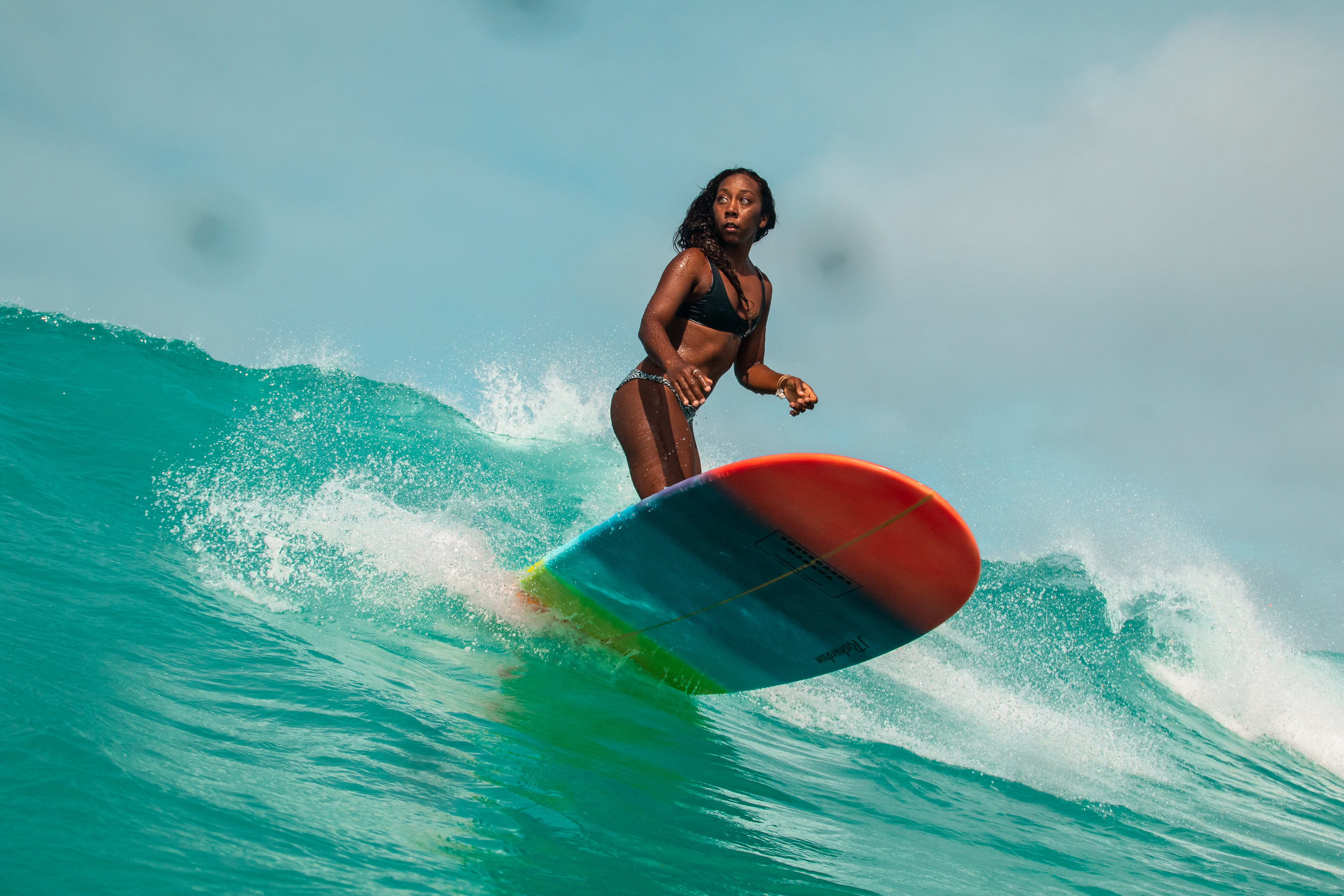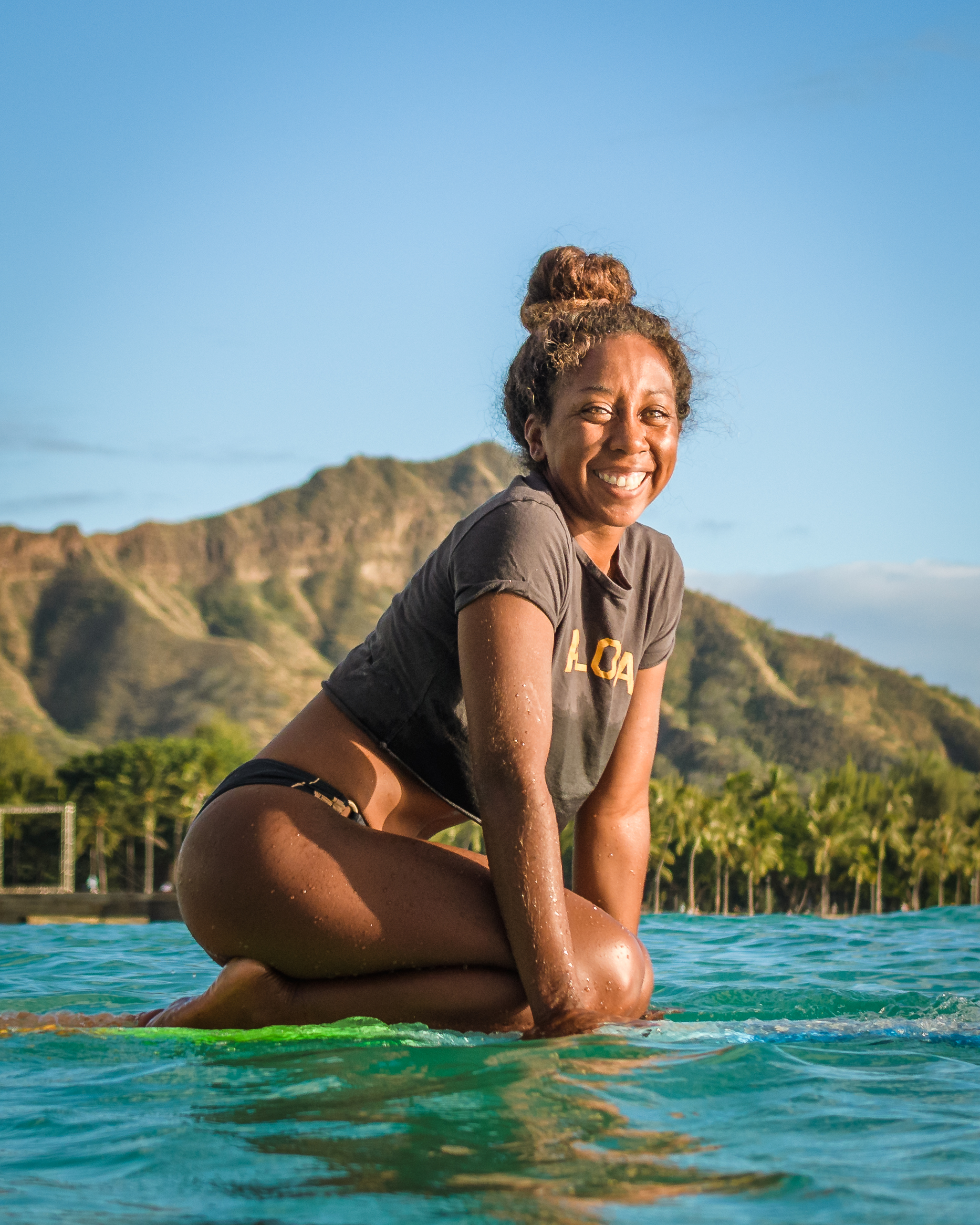African American Pro Surfer Dominique Miller Is Smashing Stereotypes on the World Tour
Photo credit: Tommy Pierucki
Stand up paddleboarder Dominique Miller is ranked ninth in the world. She’s called Oahu home for the past six years. But last September, she got on a plane and flew to New York City for the first stop of the Association of Paddlesurf Professionals (APP) World Tour. After a two year break from competing, she had to go through trials first in order to qualify for the main event. After trials, she immediately switched jerseys and paddled right back out.
She was exhausted and frustrated and placed third in her heat, but it was enough to advance. During her second round she competed against a well known surfer from Maui, Annie Reickert. Their skill level was similar but Dominique knew she had an advantage. The waves that day were breaking left. Annie is regular footed but Dominique is goofy footed. She surfs with her right leg forward and steers with her left. The two women were back and forth, always close. Annie would pull ahead in points, then Dominique. Finally, Dominique caught a pretty decent wave. She won the heat and advanced to the next round.
Photo credit: Tommy Pierucki
Her next competitor was the three time SUP world champion, Izzie Gomez. Dominique felt no pressure; her goal was to just go out there and do her best. “When you’re out there you can’t hear the scores,“ Dominique explains. When she paddled in, her boyfriend greeted her on the beach with an ecstatic “You won!” She had just knocked a three time SUP world champion out of the competition in a qualifying round.
Dominique’s head was still buzzing in disbelief the next day when she paddled back out for the semi-finals. Her mind went from ‘Dang, I just took out the world champion’ to ‘I could actually win this!’ Even though she lost the next round, it was enough to make the podium. She placed third and took home $1,500 in prize money—the same amount as the male 3rd place winner thanks to recent changes establishing equal prize money across genders.
The ensuing news coverage declared her the breakthrough performance of the world tour. There’s a photo of Dominique: quads tensed, long brown curls flying loose behind her. Goddess like. She ended 2018 as the 5th ranked woman in the world
Photo credit: Tommy Pierucki
Her dark brown skin and biracial heritage—her father is Black, while her mother is first generation Mexican American—make her a stand-out on the APP World Tour and in the World Surfing League (WSL) where she competes in longboarding—and in the competitive world of surfing sponsorships, modeling and advertising where brands have been slow to embrace racial or ethnic diversity. White and white passing models are the norm. Then there’s the fact that she didn’t grow up surfing, or even in Oahu.
Dominique is originally from Weslaco in south Texas where she spent her childhood playing youth soccer, basketball, and running. She was raised by a single mother amidst a large extended Mexican-American family. Her mother, regretting her own inability to swim, enrolled Dominique in classes and sports camps from an early age. Dominique swam before she could walk. The ocean was her comfort zone.
Photo credit: Will Walling
After high school, Dominique came to the University of Hawaii on a partial track and cross-country scholarship. She loved training and competing. It was something the 5’2” woman took to naturally. She liked winning and getting medals, but the ocean was never far from her mind. After graduating with a degree in photography she began surfing again.
Dominique is entirely self taught. She’s never had a surfing coach and she’s never taken a surfing class. Now looking back, she wonders “what the people in the lineup thought when they first saw me try to surf when I got to Hawaii? We probably looked like kooks.” Oahu was nothing like the shoulder high breaks back home in south Texas.
Undeterred, Dominique spent all of her time in the water learning from the talented pool of surfers drawn to Oahu. She would pick out the best person and watch them. Then she would try to mimic their actions. Not bad for a goofy footed kook. Eventually she started getting better and better—to the point where her friends recommended that she enter a contest.
Photo credit: Tommy Pierucki
Her first contest was in Waikiki. Dominique finished 4th in longboard and 2nd in stand up paddle boarding. After that she never really looked back. She did two additional competitions that first year The next year she surfed competitions on Oahu almost every weekend. Her third year, she entered the world tour. The first stop was at Turtle Bay in Hawaii. Some of the other destinations, like France and Abu Dhabi, were prohibitively expensive though. So she took a break and focused on her work shooting surf photography for a local surf school in Waikiki.
That meant long hours in the water every day. Dominique is aware that social media can be deceptive. She explains that “people are always telling me it doesn’t look like you work, it looks like you’re having fun all the time. I actually work a lot. I’m a surf photographer.” It’s not the easy, casual beach lifestyle that you might expect from scrolling through her social media feeds. Dominique paddles out to Queens break, shoots students and catches waves with them before paddling back in. Then she does it all over again. It’s physically demanding, unglamorous work Dominique explains, “If the waves are big, I’m getting pounded by waves but trying to be still on my board so that I get good photos.”
Photo credit: Will Walling
Then in 2018, she returned to competing on the tour. Her first stop was in Turtle Bay, Hawaii then Long Island followed by the Canary Islands. Traveling so far from her home of six years was difficult and costly. There were so many challenges: her board got damaged by the airline. She had to raise almost $3,000 to cover her plane ticket and lodging in the Canary Islands. It’s the life of a professional surfer in an industry where financial sponsorships mean everything.
Raising funds has been challenging. Her mom can’t afford to fly out from Texas to watch her daughter compete but she has dipped into her retirement fund to help cover competition fees. Competing and winning on the tour is a must for surfers like Dominique who are in search of financial sponsorship. You have to have money to make money. The tour leads to exposure and an opportunity to work with world class photographers as well. But professional surfers don’t make much money outside of brand sponsorships. And product sponsors often balk when asked to cover a $150 competition fee even while demanding that their athletes to wear their swimsuits during competitions.
Photo credit: Tommy Pierucki
Then there’s the curious experience of opening up popular surfing magazines and flipping through page after page of white athletes and models. It’s a perplexing issue in a sport that has indigenous Polynesian roots. For a biracial Mexican-American surfer like Dominique, it can engender a feeling of not quite belonging. But that’s not where her story ends.
This year, Dominique has a plan. After a slow start at the Sunset Beach Pro on the first leg of the world tour, Dominique returns to the New York SUP Open 31 August - 7th September followed by the Barbados Pro-Am 9th-17th November 2019. This time she’ll be ready. Her goal? To win the world title by 2020.







